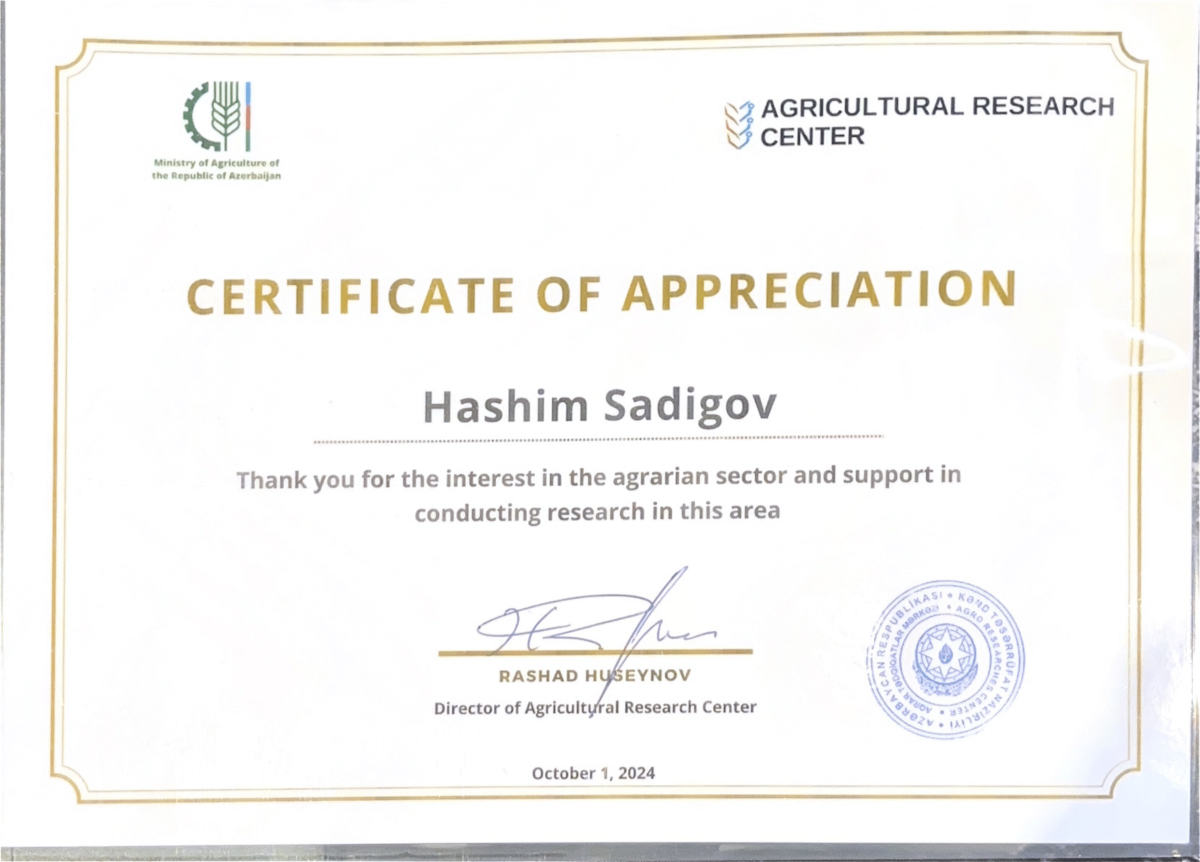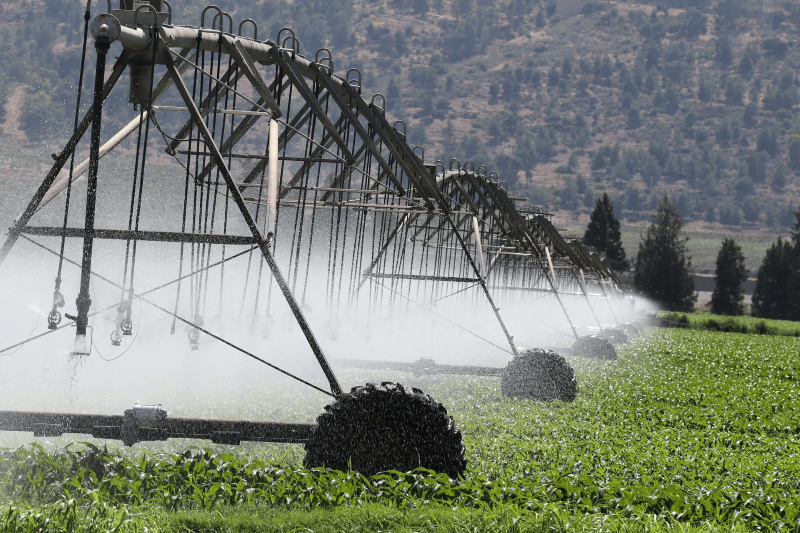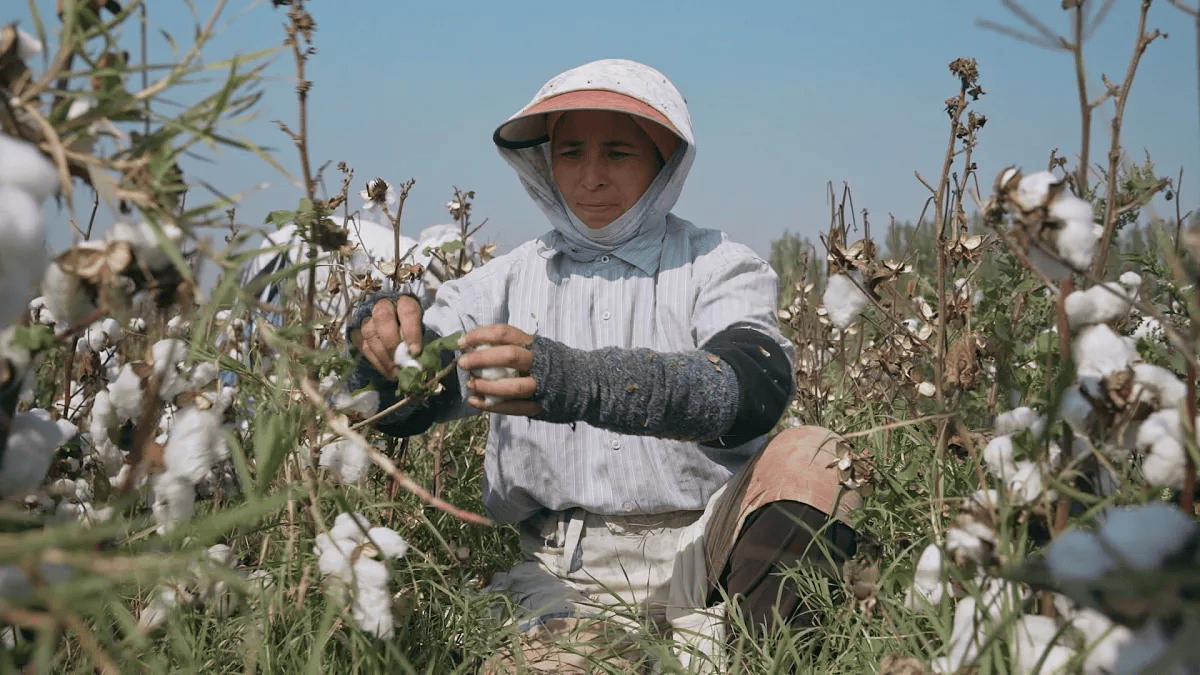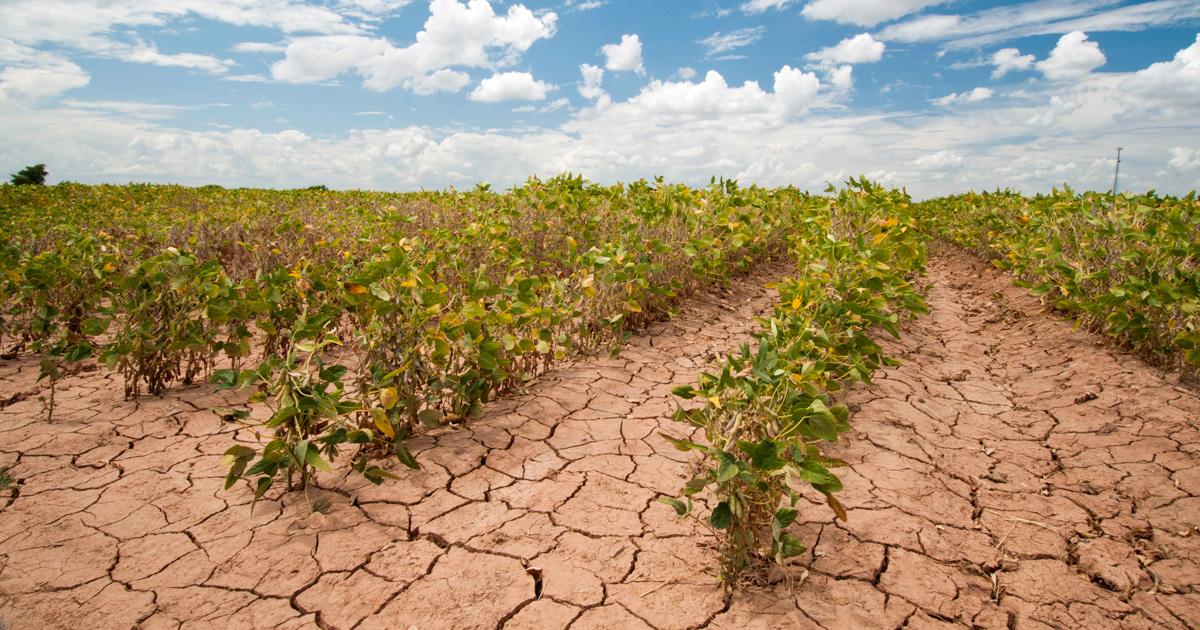Just like in most regions of the world, a drought in Azerbaijan poses significant challenges for agriculture and food security. The drought caused both by human activity and climate change adversely affects the development of rural communities, makes it difficult for farmers to access water resources, and increases their costs, leading to great losses and risks for agribusiness.
In order to reduce these risks, a tailored state policy should be implemented to manage water resources and reduce the impact of drought.
FED.az reports quoting the study "The impacts of drought on agricultural production in Azerbaijan" by young Azerbaijani researchers - high school students Hashim Sadigov and Emil Isayev as stating.
The study examines the historical and current effects of drought, economic consequences and reasons behind it, as well as the methods of combating it, and suggests drought management solutions.
The study focuses on Azerbaijan comparing the drought management experience of other countries like Kazakhstan, Turkey, UAE, Uzbekistan and Georgia.
At the same time, the study provides recommendations to the government of Azerbaijan on mitigating the impact of drought, reducing losses, and promoting sustainable agricultural practices.
The study of young researchers on this important topic has already attracted the attention of government institutions.
The Agricultural Research Center of the Ministry of Agriculture of Azerbaijan has awarded Hashim Sadigov and Emil Isayev, authors of the study "The impacts of drought on agricultural production in Azerbaijan" with a special certificate.
FED.az presents the key moments from the study "The impacts of drought on agricultural production in Azerbaijan.”
Climate change and drought. The risks it poses
Drought is a worldwide phenomenon that seriously reduces agricultural productivity and threatens food security.
Agricultural drought is caused by below-average precipitation and/or above-average temperature/wind, which evaporates moisture from soils and plants, the study states.
Drought is caused by both natural factors and human activities. Climate change, deforestation and unsustainable use of water resources are the main causes of drought.
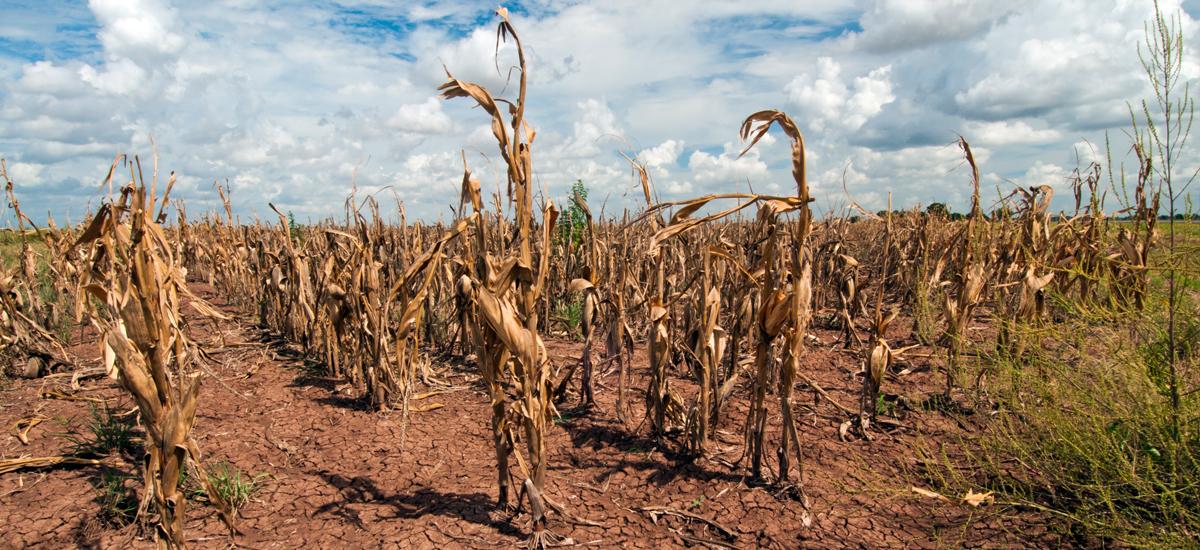
Water shortages and reduced soil moisture limit plant growth and lead to reduced crop yields. Reduced agricultural productivity leads to reduced food production, posing a threat to food security.
The study notes that drought also worsens the economic situation of rural populations. Farmers affected by drought are at risk of poverty if they cannot generate income from the sale of crops. This is a serious problem for agriculture, especially in developing countries, including Azerbaijan.
It's not just about the economic effects. Drought can alter ecosystem functions essential to agriculture, including pollination, soil maintenance, and soil fertility.
Drought around the world and its economic consequences
Drought has become a major risk worldwide, the study says. For example, the 2012 drought in the US alone primarily affected the agricultural sector (UCSUSA & NASA), causing $30 billion in damage. In the meantime, droughts cause annual losses of about 9 billion euros in the European Union and United Kingdom.
The 2014-2016 drought caused an estimated $2 billion in cropland losses and $553 million in dairy and livestock losses in California alone.
In Europe, the Mediterranean countries suffer the most from drought – Italy, Spain, Greece and Turkey are experiencing particularly severe drought conditions. Eastern European countries, including Ukraine and Romania, are also experiencing drought.
Droughts also seriously affect Africa. Three countries - Zimbabwe, Malawi and Zambia - have declared a state of emergency due to frequent droughts and reduced productivity.
According to the Famine Early Warning Systems Network (FEWS NET), all countries in the region will have below-average staple production in the 2024-2025 marketing year: a 45% decrease in Malawi, 41% in Mozambique, 55% in Zimbabwe and 34% in Zambia.
The situation in Asia is no different. Extreme heat and drought in China has reduced the country's rice yield by 8%. In the Philippines, the government spent $2.8 billion to import 14.1 million tons of rice between 2019 and 2022.
The U.S. Drought Monitor reports that an extra week of drought can reduce yields by 0.1% to 1.2% in non-irrigated areas, with the consequences of prolonged droughts being even greater.
Drought in Azerbaijan and its effects
Although the share of agriculture in the GDP is 5%, the agricultural sector plays an important role in the economy of Azerbaijan. At the same time, one third of the country's population works in agriculture.
In such a situation, drought and lack of water resources lead to serious problems in food production.
A study of Azerbaijani youth states that the effects of drought are felt throughout the food system, from suppliers of agricultural products to farmers and consumers.
It leads to negative consequences such as reduced productivity, increased food prices and reduced incomes of the rural population.
The study broadly examines Azerbaijan's water and land resources, agricultural structure, as well as irrigation practices and water use efficiency.
Thus, large rivers of Azerbaijan are fed by snow, while small rivers are fed by underground water. The largest river of the country is the 1515-kilometer Kura River, which originates from Turkey.
The country's main soil resources are dark-colored soils, which are especially widespread in the Kura-Araz plain. Of the 1.9 million hectares of arable land in the country, 1.5 million hectares are irrigated. Permanent pastures are 2.5 million hectares, and forests are 1 million hectares.
These lands mainly grow wheat, barley, corn, cotton, grapes, potatoes, vegetables and fruits. The most cultivated cereals in Azerbaijan are wheat and barley. As of 2022, Azerbaijan was the largest wheat producer in the South Caucasus, producing more than 2 million tons.
But drought and other problems seriously reduce the productivity of crops. For example, the drought resulted in a sharp drop in grain yield in 2000-2001.
Drought and water scarcity also hinders livestock farming, as a result of which the livestock sector is also negatively affected by this problem.
Irrigation practices and water use efficiency
Despite limited water resources, irrigation is very important for the agricultural sector of Azerbaijan. The irrigation systems are not efficient, with water losses in some regions reaching 60%.
The study states that this situation increases the challenges faced by farmers in accessing water, restricts irrigation opportunities and causes losses.
To solve this problem, drip irrigation and pivot systems are used, which makes water use more economic. The government funds part of the costs to support the use of modern irrigation tools and technologies.
However, the fact that more than 70% of water resources come from neighboring countries puts Azerbaijan at risk of water conflicts. Therefore, measures are being taken at the moment towards the management and development of water resources, which ensures the participation of farmers.
Drought response actions around the world
There are a number of strategies to combat drought at the international level. This is done through the development of water management, irrigation systems and insurance mechanisms in agriculture.
An interesting part of the study is related to the history of droughts in different countries and studying their experiences in dealing with droughts.
Drought in Kazakhstan - "Kazakh famine"
For example, in Kazakhstan, a neighbor of Azerbaijan, 400,000 to 750,000 people died of hunger and diseases during the "Kazakh famine", a drought caused by the wrong policy of the Soviet government in 1919-1922.
As a result of the drought in this country in 1981, the USSR was forced to import grain from abroad to meet its domestic needs.
The drought in the 2000s caused a 50% drop in grain production in Kazakhstan. Its consequences were felt not only by Kazakhstan itself, but also by Tajikistan, Uzbekistan, Kyrgyzstan and Russia.
Drought in Turkey - high inflation
In Turkey, a country with rich agriculture and an economy which is very similar to Azerbaijan, a prolonged drought in the 1970s led to a 30% drop in wheat production and a 50% drop in barley production.
The consequences of the drought that occurred in 2007-2008 were felt not only by grain producers, but by the entire population of the country. A 13% decline in wheat production and a 16% decline in barley production resulted in higher food prices and higher inflation.
What happened in Turkey revealed the importance of water management in the country to reduce the effects of drought. These experiences provide valuable lessons for Azerbaijan in shaping its agricultural strategies.
Drought in Georgia - Conditions are worsening
The study also focused on Georgia, which is neighboring to Azerbaijan and is similar in terms of climate.
Agricultural sector in Georgia, located in the South Caucasus like Azerbaijan, is the main source of income for 40% of its population. The grapes and maize cultivated here are very sensitive to drought.
Drought conditions in Georgia are becoming increasingly severe, so the government is implementing a number of policies to support farmers and mitigate the effects of drought. For example, one of the main directions of the Irrigation Policy of Georgia covering the years 2017-2025 provides for the development of irrigation infrastructure - the modernization of irrigation systems and the organization, management and financing of irrigation services for farmers. This country's experience and policy successes can be an interesting example for Azerbaijan.
Drought in Uzbekistan - Cotton production down 50%
Another focus of the study is Uzbekistan, one of the important countries of Central Asia. Uzbekistan's experience is important for Azerbaijan in terms of growing the same products.
Uzbekistan's economy is strongly dependent on agriculture, especially cotton production. Agriculture accounts for 28% of GDP and employs 27% of the workforce. The country is one of the world's leading producers of the so-called "white gold". Uzbekistan has a continental climate with hot and dry summers and cold winters, making the country vulnerable to drought.
For example, cotton production decreased by 50% leading to serious economic losses during the 2000-2001drought.
In recent times, the impact of drought has been particularly evident with the reduction of water from the Amu Darya and Syr Darya rivers in 2020. This has caused limited food supply and more dependence on imports.
Drought is not only hunger, but also rising costs
A drought also increases costs for farmers, the study says. For example, irrigation water has become more expensive by 30% in Spain due to the reduction of water resources (Eurostat).
In Germany, however, as groundwater is depleted, farmers are using deeper water pumps, leading to greater energy consumption and a 10-20% increase in costs.
In India, however, diesel prices have increased by 15-20% and energy costs by 10-15% due to the need for deeper water wells and more frequent use of diesel pumps.
Coping with drought: Solutions and suggestions
The study also includes important recommendations for drought prevention and mitigation.
1. Subsidize modern irrigation systems:
Azerbaijan can adopt Kazakhstan's successful model of subsidizing drip and sprinkler irrigation systems, which covers 80% of costs. This will increase water efficiency and increase productivity, especially in arid regions such as Gobustan and Nakhchivan.
2. Improve water management systems:
Like Kazakhstan, Azerbaijan needs to invest in modernizing its aging irrigation infrastructure and improving water management to benefit agricultural crops in arid areas.
3. Plant diversification:
As practiced in Turkey, the use of drought-resistant plants in Azerbaijan can reduce the effects of drought.
4. National Drought Management Strategy:
Implementation of a framework similar to Turkey's National Drought Management Strategy can provide region-specific water management and agricultural support, especially for critical areas such as the Araz River Basin.
5. Agricultural insurance and financial assistance:
Azerbaijan can use the approach of neighboring Georgia to implement crop insurance and financial assistance schemes. This will protect Azerbaijani farmers from drought losses and ensure their financial stability in periods of low rainfall.
6. Regional Water Resources Cooperation:
Azerbaijan should implement joint water resource management with Iran regarding the Araz River. Negotiating water sharing agreements and joint management projects can ensure reliable water supply for agricultural regions.
At a time when Azerbaijan is facing serious climate changes and risks of drought, the study conducted by Hashim Sadigov and Emil Isayev, who are young researchers, is very important in terms of drawing the attention of the public, scientific and business circles to this important topic.
It is planned to hold hearings related to this study in various scientific centers of Azerbaijan in the near future.






